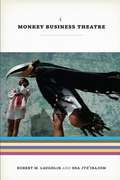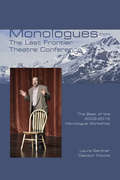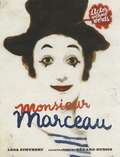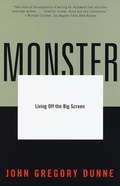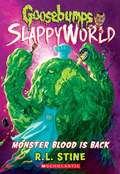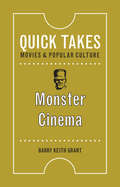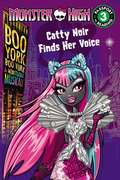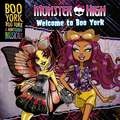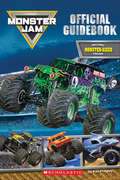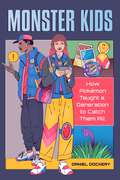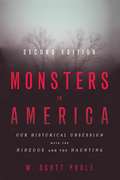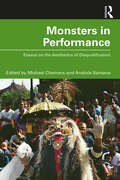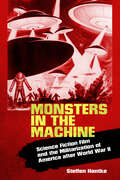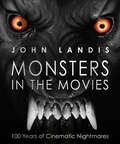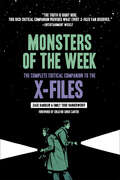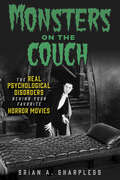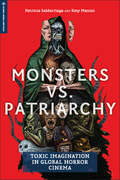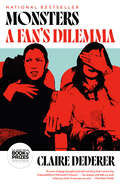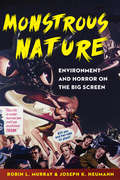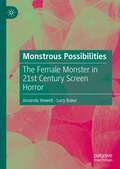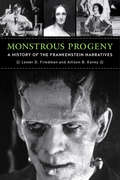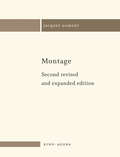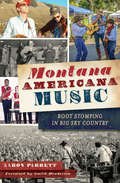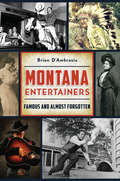- Table View
- List View
Monkey Business Theatre
by Robert M. LaughlinIn 1983, a group of citizens in San Cristóbal de las Casas, Chiapas, formed Sna Jtz'ibajom, the Tzotzil-Tzeltal Maya writers' cooperative. In the two decades since, this group has evolved from writing and publishing bilingual booklets to writing and performing plays that have earned them national and international renown. Anthropologist Robert M. Laughlin has been a part of the group since its beginnings, and he offers a unique perspective on its development as a Mayan cultural force. The Monkey Business Theatre, or Teatro Lo'il Maxil, as this branch of Sna Jtz'ibajom calls itself, has presented plays in virtually every corner of the state of Chiapas, as well as in Mexico City, Guatemala, Honduras, Canada, and in many museums and universities in the United States. It has presented to the world, for the first time in drama, a view of the culture of the Mayas of Chiapas. In this work, Laughlin presents a translation of twelve of the plays created by Sna Jtz'ibajom, along with an introduction for each. Half of the plays are based on myths and half on the social, political, and economic problems that have confronted--and continue to confront--the Mayas of Chiapas. In 1983, a group of citizens in San Cristóbal de las Casas, Chiapas, formed Sna Jtz'ibajom, the Tzotzil-Tzeltal Maya writers' cooperative. In the two decades since, this group has evolved from writing and publishing bilingual booklets to writing and performing plays that have earned them national and international renown. Anthropologist Robert M. Laughlin has been a part of the group since its beginnings, and he offers a unique perspective on its development as a Mayan cultural force. The Monkey Business Theatre, or Teatro Lo'il Maxil, as this branch of Sna Jtz'ibajom calls itself, has presented plays in virtually every corner of the state of Chiapas, as well as in Mexico City, Guatemala, Honduras, Canada, and in many museums and universities in the United States. It has presented to the world, for the first time in drama, a view of the culture of the Mayas of Chiapas. In this work, Laughlin presents a translation of twelve of the plays created by Sna Jtz'ibajom, along with an introduction for each. Half of the plays are based on myths and half on the social, political, and economic problems that have confronted - and continue to confront - the Mayas of Chiapas.
Monologues from The Last Frontier Theatre Conference: The Best of the 2009-2012 Monologue Workshop
by Laura Gardner Dawson MooreThe book contains 64 monologues designed specifically for use in the audition process. These monologues were derived from the Last Frontier Theatre Conference, one of the longest running theater conferences of its kind, held every year in Valdez, Alaska from 2009 to 2012.The monologues are honed for freshness, length, and effect and are designed for actors who are taking an audition/monologue workshop. Also included are some tips on creating monologues by Last Frontier Director Dawson Moore and for acting with the monologues by actor and mentor, Laura Gardner, both of whom selected and edited the monologues. The monologues are catagorized by gender and sorted by age of the speaker.
Monsieur Marceau: Actor Without Words
by Leda Schubert Gérard DuboisMarcel Marceau, the world's most famous mime, enthralled audiences around the world for more than fifty years. When he waved his hand or lifted his eyebrow he was able to speak volumes without ever saying a word. But few know the story of the man behind those gestures... Distinguished author Leda Schubert and award-winning artist Gerard DuBois bring their own artistry to this gorgeously written and illustrated picture book biography.
Monster
by John Gregory DunneMonster is John Gregory Dunne's mordant account of the eight years it took to get the 1996 Robert Redford/Michelle Pfeiffer film Up Close & Personal made. A bestselling novelist, Dunne has a cold eye, perfect pitch for the absurdities of Hollywood, and sharp elbows for the film industry's savage infighting. 192 pp. Author tour & national ads. 25,000 print.
Monster Blood Is Back (Goosebumps Slappyworld #13)
by R. L. StineThis is Slappy's world -- you only scream in it! Sascha Nelson and her best friend Nicole Miller love to cook! After school, they spend their time concocting new dishes in the kitchen. So when their favorite TV show Kids Big Chef Food Fights comes to their school for a special competition, they're ecstatic! But with school cheaters Ashli and Diggs also in the show, things don't seem as fun anymore. When Sascha and Nicole buy a mysterious can called Monster Blood is Back, they use it to get back at Ashli and Diggs. But as the Monster Blood grows and grows, can the two get the slime under control or will it swallow up the competition?
Monster Cinema (Quick Takes: Movies and Popular Culture)
by Barry Keith GrantMonster Cinema introduces readers to a vast menagerie of movie monsters. Some are gigantic, like King Kong or the kaiju in Pacific Rim, while others are microscopic. Some monsters appear uncannily human, from serial killers like Norman Bates to the pod people in Invasion of the Body Snatchers. And of course, other movie monsters like demons, ghosts, vampires, and witches emerge from long folklore traditions. Film expert Barry Keith Grant considers what each type of movie monster reveals about what it means to be human and how we regard the world. Armed with an encyclopedic knowledge of film history, Grant presents us with an eclectic array of monster movies, from Nosferatu to Get Out. As he discovers, although monster movies might claim to be about Them!, they are really about the capacity for horror that lurks within each of us.
Monster High: Catty Noir Finds Her Voice
by Perdita FinnA new Monster High leveled reader movie tie-in! © 2015 Mattel. All Rights Reserved.Passport to Reading Level 2
Monster High: Welcome to Boo York
by Perdita FinnIt's fright lights, big city when the Monster High ghouls head to Boo York. Cleo de Nile is invited to attend a fancy gala celebrating the return of a magical comet and, of course, she brings along her beast friends. But their trip isn't all fun and frightseeing because Nefera, Cleo's sister, uses the comet's powers for her own spooktacularly sneaky plans. Can the monsters unwrap the mystery of the comet in time to stop Nefera?
Monster Jam Official Guidebook
by Kiel PhegleyDon't miss this definitive guide to the biggest, baddest competition in the world! Take a look under the hood and learn what it takes to make these massive trucks go, get the inside scoop on the oldest rivalries among the teams, and take a crash course from Monster Jam University, where ordinary drivers become superstars. It's all here in the Monster Jam Official Guidebook, which comes complete with a giant, double-sided poster! A must-have for fans and future drivers alike!
Monster Kids: How Pokémon Taught a Generation to Catch Them All
by Daniel DockeryThe definitive, behind-the-scenes look at why Pokémon's evolution from a single Japanese video game to global powerhouse captured the world's attention, and how the "gotta catch 'em all" mentality of its fanbase shaped pop culture—and continues to do so today. More than just a simple journey through the history of Pokémon, Daniel Dockery offers an in-depth look at the franchise&’s many branches of impact and influence. With dozens of firsthand interviews, Monster Kids covers its beginnings as a Japanese video game created to recapture one man's love of bug-collecting as a child before diving into the decisions and conditions that would ultimately lead to that game's global domination. With its continued growth as television shows, spin-off video games, blockbuster movies, trading cards, and toys, Pokémon is a unique and special brand that manages to continue to capture the attention and adoration of its eager fanbase 25 years after its initial release. Whether it was new animated shows like Digimon, Cardcaptors, and Yu-Gi-Oh!; the rise of monster-catching video games and trading card games; and more, Pikachu, the king of pop culture in the '90s, opened the doors in America to those hoping to capture some of Pokémon's dedicated fans. In Monster Kids, Dockery combines the personal stories of the people who helped bring Pokémon to the global stage with affection and humor, making this book the ultimate look at the rise of the franchise in Japan and then North America, but also the generation of kids whose passion for "catching them all" created a unique cultural phenomenon that continues to make a profound impact today.
Monster Manual
by Gary GygaxThe first of the compilations of monsters and fores for players of the Advanced Dungeons and Dragons game to do battle with.
Monsters in America: Our Historical Obsession with the Hideous and the Haunting
by W. PooleMonsters arrived in 2011―and now they are back. Not only do they continue to live in our midst, but, as historian Scott Poole shows, these monsters are an important part of our past―a hideous obsession America cannot seem to escape. <p><p> Poole’s central argument in Monsters in America is that monster tales intertwine with America’s troubled history of racism, politics, class struggle, and gender inequality. The second edition of Monsters leads readers deeper into America’s tangled past to show how monsters continue to haunt contemporary American ideology. <p> By adding new discussions of the American West, Poole focuses intently on the Native American experience. He reveals how monster stories went west to Sand Creek and Wounded Knee, bringing the preoccupation with monsters into the twentieth century through the American Indian Movement. In his new preface and expanded conclusion, Poole’s tale connects to the present―illustrating the relationship between current social movements and their historical antecedents. This proven textbook also studies the social location of contemporary horror films, exploring, for example, how Get Out emerged from the context of the Black Lives Matter movement. Finally, in the new section "American Carnage," Poole challenges readers to assess what their own monster tales might be and how our sordid past horrors express themselves in our present cultural anxieties. <p> By the end of the book, Poole cautions that America’s monsters aren’t going away anytime soon. If specters of the past still haunt our present, they may yet invade our future. Monsters are here to stay.
Monsters in Performance: Essays on the Aesthetics of Disqualification
by Analola Santana Michael ChemersMonsters in Performance boasts an impressive range of contemporary essays that delve into topical themes such as race, gender, and disability, to explore what constitutes monstrosity within the performing arts. These fascinating essays from leading and emerging scholars explore representation in performance, specifically concerning themselves with attempts at social disqualification of "undesirables." Throughout, the writers employ the concept of "monstrosity" to describe the cultural processes by which certain identities or bodies are configured to be threateningly deviant. The editors take a range of previously isolated critical inquiries – including bioethics, critical race studies, queer studies, and televisual studies - and merge them to create an accessible and dynamic platform which unifies these ranges of representations. The global scope and interdisciplinary nature of Monsters in Performance renders it an essential book for Theatre and Performance students of all levels as well as scholars; it will also be an enlightening text for those interested in monstrosity and Cultural Studies more broadly.
Monsters in the Machine: Science Fiction Film and the Militarization of America after World War II
by Steffen HantkeDuring the 1950s and early 1960s, the American film industry produced a distinct cycle of films situated on the boundary between horror and science fiction. Using the familiar imagery of science fiction--from alien invasions to biological mutation and space travel--the vast majority of these films subscribed to the effects and aesthetics of horror film, anticipating the dystopian turn of many science fiction films to come. Departing from projections of American technological awe and optimism, these films often evinced paranoia, unease, fear, shock, and disgust. Not only did these movies address technophobia and its psychological, social, and cultural corollaries; they also returned persistently to the military as a source of character, setting, and conflict. Commensurate with a state of perpetual mobilization, the US military comes across as an inescapable presence in American life.Regardless of their genre, Steffen Hantke argues that these films have long been understood as allegories of the Cold War. They register anxieties about two major issues of the time: atomic technologies, especially the testing and use of nuclear weapons, as well as communist aggression and/or subversion. Setting out to question, expand, and correct this critical argument, Hantke follows shifts and adjustments prompted by recent scholarly work into the technological, political, and social history of America in the 1950s. Based on this revised historical understanding, science fiction films appear in a new light as they reflect on the troubled memories of World War II, the emergence of the military-industrial complex, the postwar rewriting of the American landscape, and the relative insignificance of catastrophic nuclear war compared to America's involvement in postcolonial conflicts around the globe.
Monsters in the Movies: 100 Years of Cinematic Nightmares
by John LandisFrom B-movie bogeymen and outer space oddities to big-budget terrors, Monsters in the Movies by legendary filmmaker John Landis showcases the greatest monsters ever to creep, fly, slither, stalk, or rampage across the Silver Screen! Landis provides his own fascinating and entertaining insights into the world of moviemaking, while conducting in-depth "conversations" with leading monster makers, including David Cronenberg, Christopher Lee, John Carpenter, and Sam Raimi — to discuss some of the most petrifying monsters ever seen. He also surveys the historical origins of the archetypal monsters, such as vampires, zombies, and werewolves, and takes you behind the scenes to discover the secrets of those special-effects wizards who created such legendary frighteners as King Kong, Dracula, and Halloween's Michael Myers. With more than 1000 stunning movie stills and posters, this book is sure to keep even the most intense fright-seekers at the edge of their seats for hours!
Monsters of the Week: The Complete Critical Companion to The X-Files
by Zack Handlen Emily Todd VanDerWerffThe complete critical companion to The X-Files, covering every episode and both films and featuring interviews with screenwriters and stars.In Monsters of the Week: The Complete Critical Companion to The X-Files, TV critics Zack Handlen and Emily Todd VanDerWerff look back at exactly what made the long-running cult series so groundbreaking. Packed with insightful reviews of every episode—including the tenth and eleventh seasons and both major motion pictures—Monsters of the Week leaves no mystery unsolved and no monster unexplained. This crucial collection includes a foreword by series creator Chris Carter as well as exclusive interviews with some of show’s stars and screenwriters, including Carter, Vince Gilligan, Mitch Pileggi, James Wong, Robert Patrick, Darin Morgan, and more. Monsters of the Week is the definitive guide to The X-Files—whether you’re a lifelong viewer or a new fan uncovering the conspiracy for the first time. “This rich critical companion provides what evert X-Files fan deserves.” —Entertainment Weekly “The X-Files is my favorite show and Zack and Emily are my favorite reviewers of my favorite show and this is my favorite quote about it.” —Kumail Nanjiani, writer and star of The Big Sick; creator of The X-Files Files podcast“If Mulder and Scully had access to this terrific book, they would’ve solved every mystery of The X-Files in a single season. . . . The truth is in here!” —Damon Lindelof, co-creator of Lost and The Leftovers
Monsters on the Couch: The Real Psychological Disorders Behind Your Favorite Horror Movies
by Brian A. SharplessHorror movies can reveal much more than we realize about psychological disorders—and clinical psychology has a lot to teach us about horror. Our fears—mortality, failure, loneliness—can be just as motivating as our wishes or desires. Horror movie characters uniquely reveal all of these to a wide audience. If explored in an honest and serious manner, our fears have the potential to teach us a great deal about ourselves, our culture, and certainly other people. From psychologist, researcher, and horror film enthusiast Brian A. Sharpless comes Monsters on the Couch, an exploration into the real-life psychological disorders behind famous horror movies. Accounts of clinical syndromes every bit as dramatic as those on the silver screen are juxtaposed with fascinating forays into the science and folklore behind our favorite movie monsters. Horror fans may be obsessed with vampires, werewolves, zombies, and the human replacements from Invasion of the Body Snatchers, but even many medical professions may not know about the corresponding conditions of Renfield's syndrome, clinical lycanthropy, Cotard's syndrome, and the misidentification delusions. Some of these disorders are surprisingly common in the general population. For instance, a number of people experience isolated sleep paralysis, a disorder implicated in ghost and alien abduction beliefs.As these tales unfold, readers not only learn state-of-the-art psychological science but also gain a better understanding of history, folklore, and how Hollywood often—but not always—gets it wrong when tackling these complex topics.
Monsters vs. Patriarchy: Toxic Imagination in Global Horror Cinema (Global Media and Race)
by Patricia Saldarriaga Emy ManiniAcross the globe, the violent effects of patriarchy are manifest. Women, trans people, gender-nonconforming people, and the racialized Other are regularly subjected to physical danger, beginning with the denial of vitally important health care, and, in its most horrific form, rape, trafficking, and murder. Monsters vs. Patriarchy links these real-world horrors to the monstrification and dehumanization of people as expressed in contemporary global cinema. This monstrification has been achieved through a toxic imagination attributed to women, a trait that historically referred to the power of women to negatively affect others, including their own children in the womb, with only the use of their imagination. This process reflects the misogynist and racist world in which we live, where female bodies, people of color, and alternative identities represent a threat to patriarchal power. Monsters vs. Patriarchy examines female monstrosity as it appears in horror films from around the world and considers specific political, scientific, and historical contexts to better understand how we construct and reconstruct monstrosity, using an intersectional approach to examine the imposition of gender and racial hierarchies that support national power structures. The authors contend that monstrous female cinematic subjects, including ghosts, witches, cannibals, and posthuman beings, are becoming empowered, using the tools of their monstrification to smash the colonial, white supremacist, and misogynist structures that created them.
Monsters: A Fan's Dilemma
by Claire DedererA NEW YORK TIMES NOTABLE BOOK • NATIONAL BESTSELLER • A timely, passionate, provocative, blisteringly smart interrogation of how we make and experience art in the age of cancel culture, and of the link between genius and monstrosity. Can we love the work of controversial classic and contemporary artists but dislike the artist?"A lively, personal exploration of how one might think about the art of those who do bad things" —Vanity Fair • "[Dederer] breaks new ground, making a complex cultural conversation feel brand new." —Ada Calhoun, author of Also a Poet From the author of the New York Times best seller Poser and the acclaimed memoir Love and Trouble, Monsters is &“part memoir, part treatise, and all treat&” (The New York Times). This unflinching, deeply personal book expands on Claire Dederer&’s instantly viral Paris Review essay, "What Do We Do with the Art of Monstrous Men?" Can we love the work of artists such as Hemingway, Sylvia Plath, Miles Davis, Polanski, or Picasso? Should we? Dederer explores the audience's relationship with artists from Michael Jackson to Virginia Woolf, asking: How do we balance our undeniable sense of moral outrage with our equally undeniable love of the work? Is male monstrosity the same as female monstrosity? And if an artist is also a mother, does one identity inexorably, and fatally, interrupt the other? In a more troubling vein, she wonders if an artist needs to be a monster in order to create something great. Does genius deserve special dispensation? Does art have a mandate to depict the darker elements of the psyche? And what happens if the artist stares too long into the abyss? Highly topical, morally wise, honest to the core, Monsters is certain to incite a conversation about whether and how we can separate artists from their art.&“Monsters leaves us with Dederer&’s passionate commitment to the artists whose work most matters to her, and a framework to address these questions about the artists who matter most to us." —The Washington PostA Best Book of the Year: The New York Times, NPR, The Washington Post, The New Yorker, Vulture, Elle, Esquire, Kirkus
Monstrous Nature: Environment and Horror on the Big Screen
by Robin L. Murray Joseph K. HeumannGodzilla, a traditional natural monster and representation of cinema’s subgenre of natural attack, also provides a cautionary symbol of the dangerous consequences of mistreating the natural world—monstrous nature on the attack. Horror films such as Godzilla invite an exploration of the complexities of a monstrous nature that humanity both creates and embodies. Robin L. Murray and Joseph K. Heumann demonstrate how the horror film and its offshoots can often be understood in relation to a monstrous nature that has evolved either deliberately or by accident and that generates fear in humanity as both character and audience. This connection between fear and the natural world opens up possibilities for ecocritical readings often missing from research on monstrous nature, the environment, and the horror film. Organized in relation to four recurring environmental themes in films that construct nature as a monster—anthropomorphism, human ecology, evolution, and gendered landscapes—the authors apply ecocritical perspectives to reveal the multiple ways nature is constructed as monstrous or in which the natural world itself constructs monsters. This interdisciplinary approach to film studies fuses cultural, theological, and scientific critiques to explore when and why nature becomes monstrous.
Monstrous Possibilities: The Female Monster in 21st Century Screen Horror
by Lucy Baker Amanda HowellThis book focuses on how the abject spectacle of the ‘monstrous feminine’ has been reimagined by recent and contemporary screen horrors focused on the desires and subjectivities of female monsters who, as anti-heroic protagonists of revisionist and reflexive texts, exemplify gendered possibility in altered cultures of 21st century screen production and reception. As Barbara Creed notes in a recent interview, the patriarchal stereotype of horror that she named ‘the monstrous-feminine’ has, decades later, ‘embarked on a life of her own’. Focused on this altered and renewed form of female monstrosity, this study engages with an international array of recent and contemporary screen entertainments, from arthouse and indie horror films by emergent female auteurs, to the franchised products of multimedia conglomerates, to 'quality' television horror, to the social media-based creations of horror fans working as ‘pro-sumers’. In this way, the monograph in its organisation and scope maps the converged and rapidly changing environment of 21st century screen cultures in order to situate the monstrous female anti-hero as one of its distinctive products.
Monstrous Progeny: A History of the Frankenstein Narratives
by Lester D. Friedman Allison B. KaveyMary Shelley's 1818 novel Frankenstein is its own type of monster mythos that will not die, a corpus whose parts keep getting harvested to animate new artistic creations. What makes this tale so adaptable and so resilient that, nearly 200 years later, it remains vitally relevant in a culture radically different from the one that spawned its birth? Monstrous Progeny takes readers on a fascinating exploration of the Frankenstein family tree, tracing the literary and intellectual roots of Shelley's novel from the sixteenth century and analyzing the evolution of the book's figures and themes into modern productions that range from children's cartoons to pornography. Along the way, media scholar Lester D. Friedman and historian Allison B. Kavey examine the adaptation and evolution of Victor Frankenstein and his monster across different genres and in different eras. In doing so, they demonstrate how Shelley's tale and its characters continue to provide crucial reference points for current debates about bioethics, artificial intelligence, cyborg lifeforms, and the limits of scientific progress. Blending an extensive historical overview with a detailed analysis of key texts, the authors reveal how the Frankenstein legacy arose from a series of fluid intellectual contexts and continues to pulsate through an extraordinary body of media products. Both thought-provoking and entertaining, Monstrous Progeny offers a lively look at an undying and significant cultural phenomenon.
Montage (Theories Of Representation And Difference Ser.)
by Jacques AumontDescribing editing as cinema's formal and aesthetic soul because of its ability to represent time, in this wide-ranging essay Jacques Aumont surveys the theory and practice of editing and montage from early cinema to the digital era. Aumont addresses the Soviet filmmaker-theorists of the 1920s, of course – he is a translator of Eisenstein and the author of a book on Eisenstein's montage – but also brings into the discussion contemporary directors such as Jia Zhangke, Abbas Kiarostami, Aleksandr Sokurov, Kathryn Bigelow and Lisandro Alonso, with stops along the way for the ideas of André Bazin, Jean-Luc Godard and Pier Paolo Pasolini. This original essay is essential reading by one of the leading film scholars at work in the world today and a rare opportunity for English speakers to enjoy his work. This expanded and revised edition adds a dozen pages to the original volume. "We have entered into a period in which the reign of vision has become contested by that of the image, with the result that editing has changed nature, because its job is no longer to regulate a succession of shots as much as it is to regulate a succession of images. And while the shot has a responsibility towards reality, the image is responsible only to itself." — Jacques Aumont
Montana Americana Music: Boot Stomping in Big Sky Country
by Smith Henderson Aaron ParrettMontana's relationship to Americana music is as wide and deep as the famed Missouri River that inspired countless musicians seated at its shores. From the fiddling of Pierre Cruzatte and George Gibson in the Corps of Discovery to the modern-day loner folk of Joey Running Crane and Cameron Boster, the Treasure State inspires the production of top-notch country music. In the 1950s, bands like the Snake River Outlaws fostered a long-standing love of hillbilly honky-tonk, and in the 1970s, the Mission Mountain Wood Band added a homegrown flavor of its own. Contemporary acts like the Lil' Smokies and songwriter Martha Scanlan promise a vibrant future for the local sound. Author and musician Aaron Parrett explores this history to show what it means to boot stomp in Big Sky Country.
Montana Entertainers: Famous and Almost Forgotten
by Brian D'AmbrosioTreasure State stars Gary Cooper and Myrna Loy found unparalleled success during the Golden Age of Hollywood. For more than a century, Montana has supplied a rich vein of entertainment and personality--from daredevils to dancers and even mimes. Born in Miles City in 1895, comedian Gilbert "Pee Wee" Holmes played sidekick to such stars as Tom Mix. One-time Butte resident Julian Eltinge went on to become America's first famous female impersonator. There was Taylor Gordon, whose golden voice propelled the son of a slave from White Sulphur Springs to Harlem Renaissance fame. From the little-known Robyn Adair to the ever-popular Michelle Williams, author Brian D'Ambrosio marks Big Sky Country's long-standing connections with America's performing arts.
